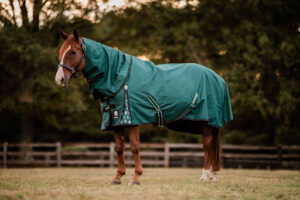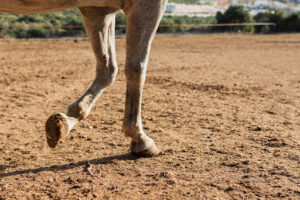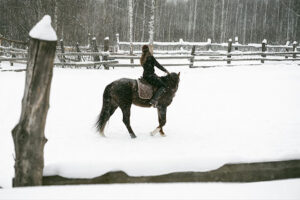The Dressage Scales of Training: Connection (Part 3 of 6)
Welcome to our third instalment on the scales of training. In parts one and two, we discussed the first two scales: rhythm and suppleness. In part three, we’ll be looking at connection – or contact, as some people call it. Not only will you learn exactly where the scales of training came from and how […]

Welcome to our third instalment on the scales of training. In parts one and two, we discussed the first two scales: rhythm and suppleness. In part three, we’ll be looking at connection – or contact, as some people call it.
Not only will you learn exactly where the scales of training came from and how they relate to one another, but also what connection refers to and how to identify a horse who shows good connection. Plus, we’ll look at why contact and connection actually mean (slightly) different things.
If you haven’t done so yet, read part one (rhythm) and part two (suppleness) for a better overall understanding of the pyramid of training.
What the ‘Scales of Training’ Means
Originally, the scales of training were used in training of the German military horses. Although there are fewer horses used for cavalry purposes today, equestrian sport (and dressage in particular) still strive for a horse who is rideable, responsive, and supple. As a result, the scales of training are just as relevant today as they were then. Since then, the scales of training (also called the pyramid of training) have been translated into English, and are used globally as a reference point for how to school a horse.
Thinking of the scales of training as a pyramid is often helpful. This pyramid is composed of six elements which are interrelated. That said, the lower scales form the foundation (or base of the pyramid) upon which the higher scales are built.
The six scales are:
- Rhythm
- Suppleness/Relaxation
- Connection/Contact
- Impulsion
- Straightness
- Collection
The scales are interrelated. The idea isn’t that each step must be 100% established or perfected before you can move on to the next scale. For instance, a 1st level horse doesn’t simply “finish” working on connection. If they did, the connection would be the same as it is in a Grand Prix horse, which isn’t true. So, you can almost always be improving upon each of the scales at any given time. However, they are very useful as a reference for understanding the general way in which a horse progresses up the grades.
The scales are also interrelated in the sense that by improving one, you also tend to improve another. For example, improving collection will also improve your horse’s connection. And in the opposite direction, improving the connection and contact will allow your horse to take more weight on the hind leg and develop his collection. So each scale can influence the other scales.
At a very broad level, it’s often said that first three scales form the beginning stages of a horse’s training. A newly-backed horse, for instance, needs to learn to trot and canter while relaxed and rhythmical before you can start thinking about collection. But the need to work on these scales doesn’t disappear once your horse has basic schooling – it’s an ongoing process. The scales of training can be a difficult and complex topic (like everything dressage!) so if you’re stuck, you can read Michael Eilberg’s explanation here. Hopefully, this will give you a strong understanding of how all the scales of training work in tandem to produce a Grand Prix horse.
With that in mind, let’s take a look at the third scale – connection. Or as some people call it, contact.
What is Connection in Dressage?
The USDF defines connection as “acceptance of the bit through acceptance of the aids.” They go on to say that ‘the energy generated in the hindquarters by the driving aids must flow through the whole body of the horse and is received in the rider’s hands. The contact to the bit must be elastic and adjustable, creating fluent interaction between horse and rider with appropriate changes in the horse’s outline. Acceptance of the bit is identified by the horse quietly chewing the bit. This activates the salivary glands so that the mouth becomes moist and production of saliva is evident. The softly moving tongue should remain under the bit. The quality of the connection and balance can be evaluated by ‘überstreichen’, releasing the reins (to demonstrate self carriage) or by allowing the horse to chew the reins out of the hands (to demonstrate relaxation).”
Contact and connection are often used interchangeably, but many experienced riders and judges prefer the term connection. Why? Contact refers mostly to the actual contact between the horse’s mouth and the rider. But connection refers to the overall connection through the entire body rather than just the contact with the mouth. A horse accepting the contact is, of course, a prerequisite to good connection. You might also hear people describing connection as a horse being “through.”

So, What Does Good Connection Look Like?
A good connection essentially means the horse accepts and responds to all of the aids willingly. When this happens, the horse and rider appear in good harmony and the energy generated by the horse’s hind legs have been connected to a light and elastic contact in front. You can, therefore, feel the activity of the hind legs through your reins – and each “end” of the horse can influence the other.
A good test as to whether your connection is good or not is to first try a stretching circle in all gaits, and then to try releasing the reins forward. As you just read above, this is called “überstreichen” in German. If your horse follows the contact forward and down in the stretch while remaining active and over the back, that’s a sign of a good connection. If your horse remains in self carriage and doesn’t change balance, it’s another good sign. But if your horse falls onto the forehand, hollows, rushes, or drops out of the gait in either instance, then your connection is not secure.
Other visual signs of a good contact include a swinging and relaxed back, a closed mouth with light foam, an active hind leg, the poll being the highest point of the neck, a frame which is suitable to the pace (rather than strung out or tight and short in the neck), and a relaxed tail and general expression. On the other hand, opening of the jaw, rushing or appearing sluggish, hollowing or fighting the hand, and other resistance to the aids is usually a sign of a connection which needs improvement. So as you can see, it’s about far more than just the mouth!
How Can You Improve Connection?
Connection is one of those things which is kind of like the holy grail! Once you’ve felt what good connection is like, it becomes much easier to replicate it. And until then, you’re often not sure exactly what amount of pressure to apply from the aids, when to release it, and how to actually make your horse respond. So admittedly, feel is a major part of connection.
That said, there are plenty of exercises which can improve connection. The first is stretching, also sometimes called “long and low.” Teaching your horse to stretch into the contact at all gaits (starting with walk) is invaluable in teaching them to “seek” the contact. It’s important that you ride the horse forward into the stretch rather than pulling them downwards with your hands. Here’s a helpful article if you’re not sure where to start when it comes to getting your horse to stretch.
Then, remember that connection is essentially the recycling of the energy from hind leg to front end and then back again. So it makes sense that any exercises which involve activating the hind leg and riding into a contact would be helpful. Transitions are your best friend when it comes to improving connection. Not only do they get the hind legs moving more powerfully, but they help to lighten the forehand too. But it’s important not to hold the horse down during your transitions – instead, self-carriage and suppleness should be what keep the horse in a good frame as you change gait or pace.
Conclusion
Connection is often a confusing concept for riders, and is undoubtedly one of the hardest to master. But once you’ve got it, you’ll find it becomes much easier to ride almost any horse. And without good connection, your horse will always struggle to progress in his schooling.
The next article will cover the fourth scale, which is impulsion. In the meantime, let us know in the comments if you have any thoughts on how to improve connection in a horse.







